人教课标版B9 Unit 3 Australia Workbook-Listening(课件29张)
文档属性
| 名称 | 人教课标版B9 Unit 3 Australia Workbook-Listening(课件29张) |  | |
| 格式 | zip | ||
| 文件大小 | 2.2MB | ||
| 资源类型 | 教案 | ||
| 版本资源 | 人教版(新课程标准) | ||
| 科目 | 英语 | ||
| 更新时间 | 2015-09-19 16:46:22 | ||
图片预览

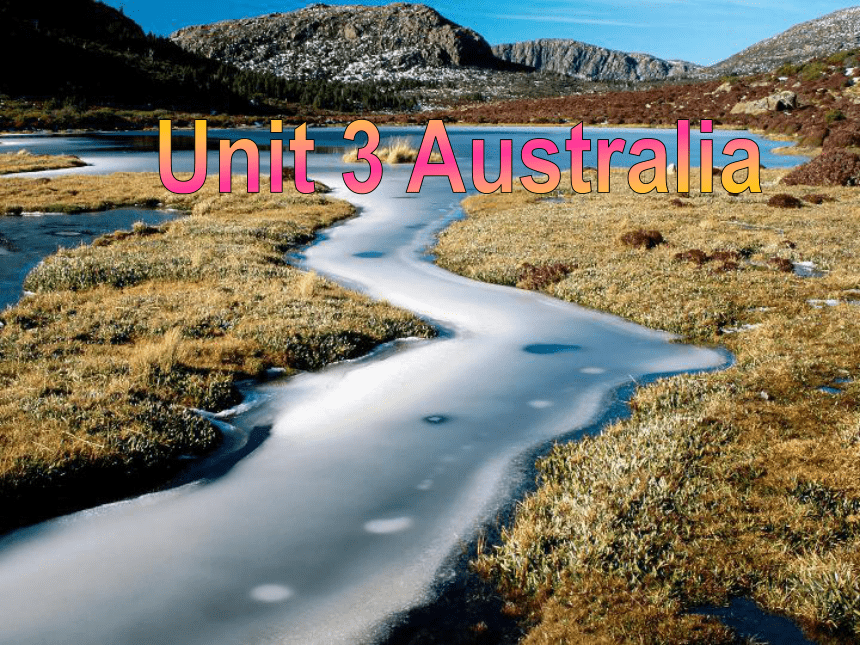
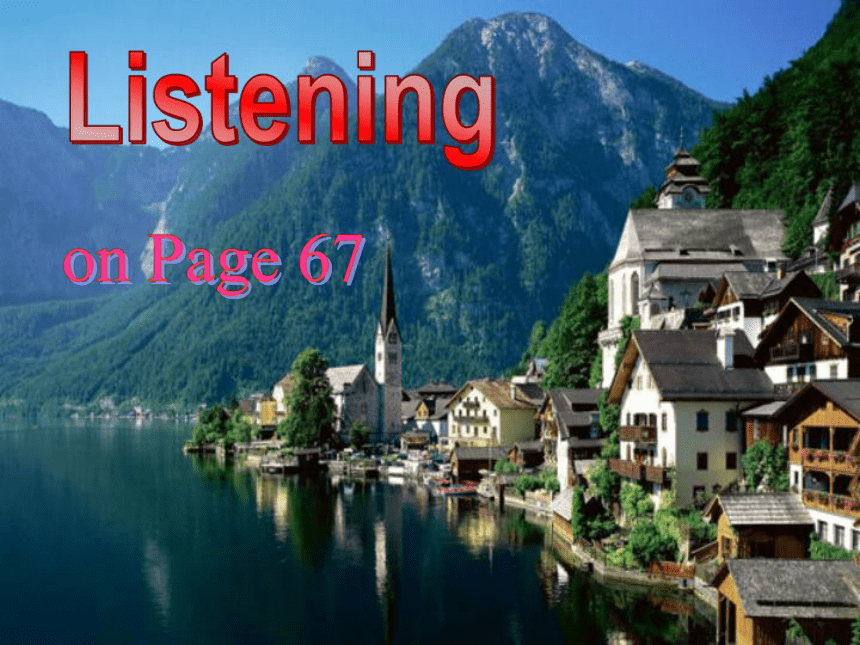
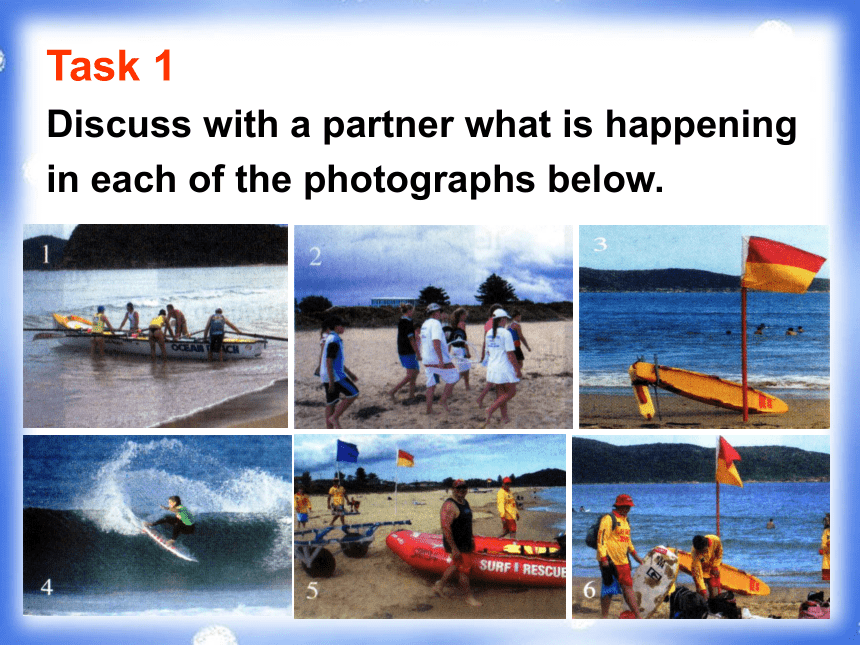
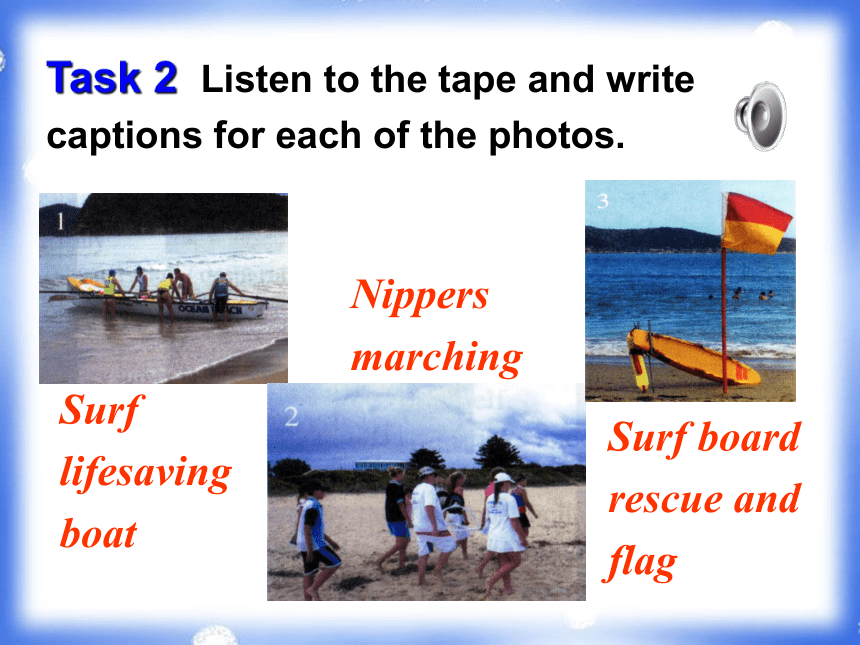
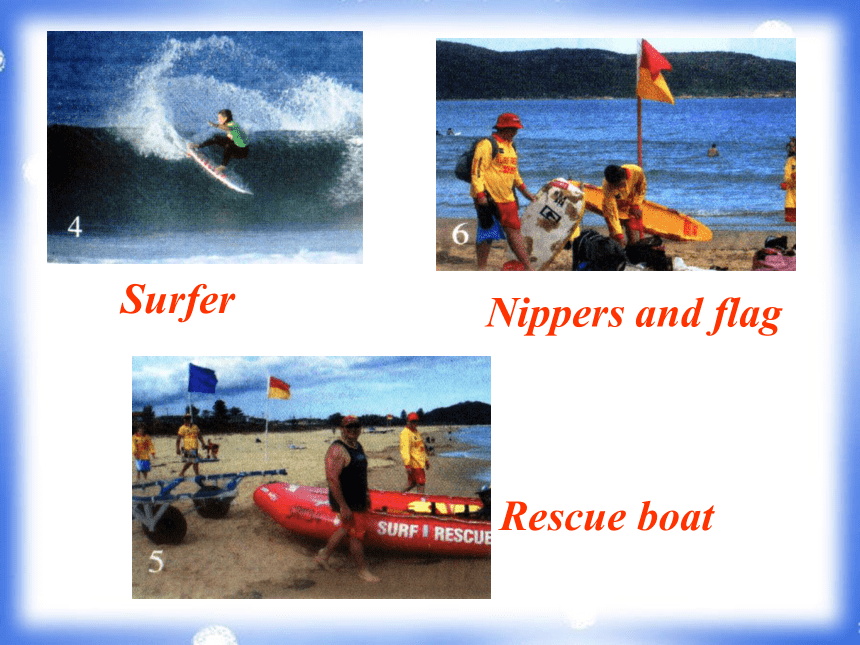
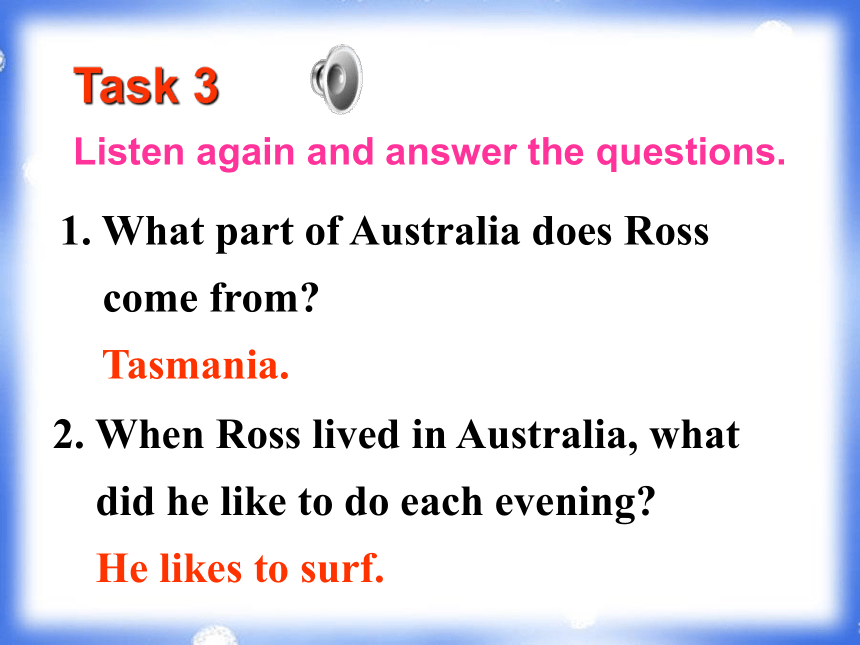
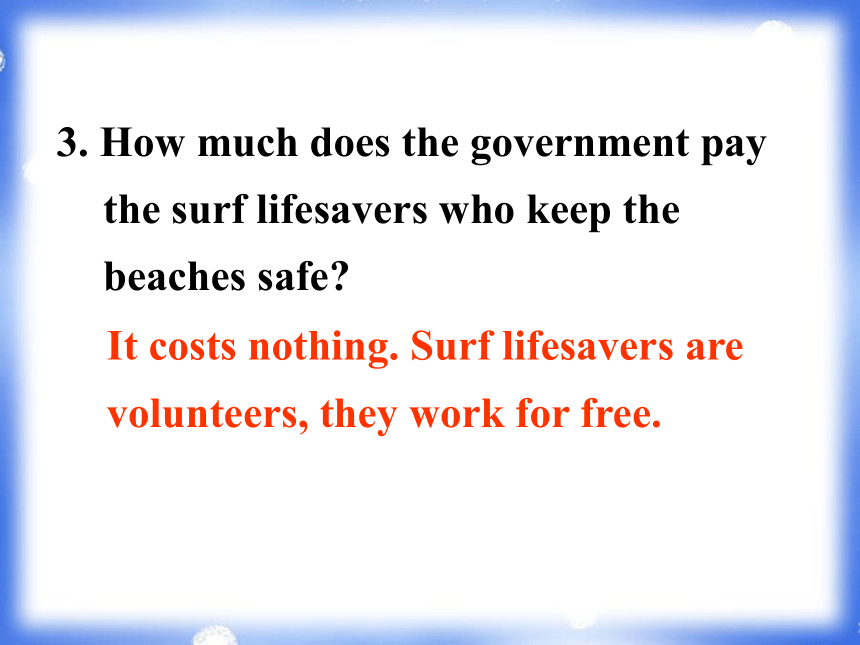
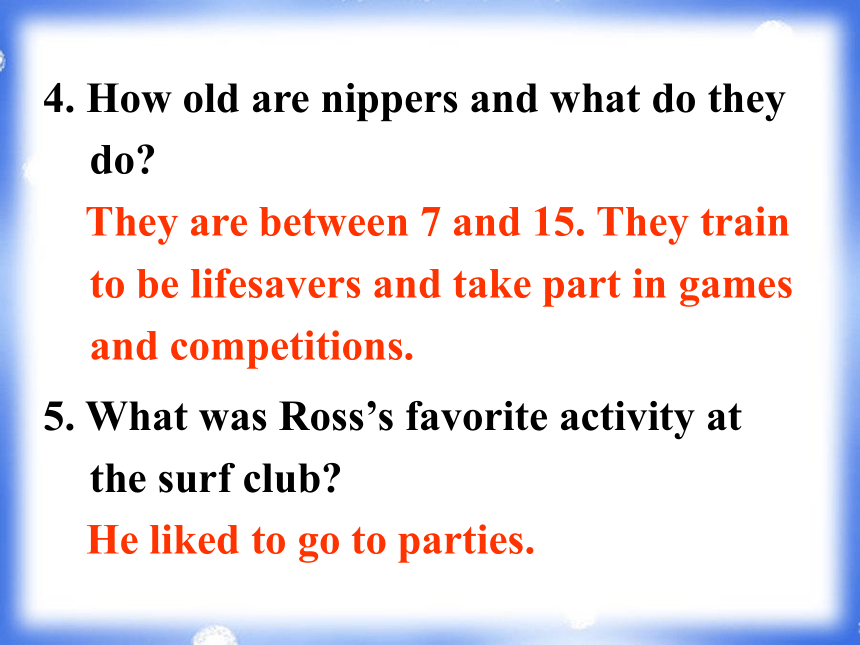
文档简介
课件29张PPT。人教课标
高三 选修 9
Unit 3Unit 3 AustraliaListening on Page 67Task 1
Discuss with a partner what is happening in each of the photographs below. Surf lifesaving boatNippers marchingSurf board rescue and flagTask 2 Listen to the tape and write captions for each of the photos. SurferRescue boatNippers and flag1. What part of Australia does Ross
come from?
Tasmania.2. When Ross lived in Australia, what
did he like to do each evening?
He likes to surf.Task 3
Listen again and answer the questions. 3. How much does the government pay the surf lifesavers who keep the beaches safe? It costs nothing. Surf lifesavers are volunteers, they work for free. 4. How old are nippers and what do they do?
They are between 7 and 15. They train to be lifesavers and take part in games and competitions. 5. What was Ross’s favorite activity at the surf club?
He liked to go to parties.Listen once more and give your definition. surf
surf lfesaver
surf lifesaving club
nipper
ironman / woman competitionTask 4surf (v.): to ride the waves into the beach on a surf board;
surf (n.): the waves in the sea that are close to the shore and have white foam on the top.
surf lifesaver: someone who rescues people who get in trouble in the waves.surf lifesaving club: a social and sports club that patrols beaches to keep swimmers safe.
nipper: a junior member of a surf lifesaving club (between 7 and 15 years old).ironman/woman competition: a combination of three different races --- a swim, a foot race and a paddling race in a canoe or on surfboard.Speaking and
Listening taskon Page 71Discuss these questions with your group. Why do countries have flags?
What can flags tell you about a country? Think of some examples.
What does China’s national flag tell us?
What other organizations do you know that have flags? What do they use them for?Pre-listening 1. Why do countries have flags?
A flag usually stands as a symbol for that country. It can remind people of some important values the nation holds or something of its history or culture. It is used on official occasions to identify the nation to the rest of the world.2. What can flags tell you about a country? Think of some examples.
They can tell people about the nations, history, values or culture. For example, the stars on the US flag represent the states in the union. The cross on the Greek flag symbolizes Christianity. The maple leaf on the Canadian flag is the national emblem of Canada.3. What does China’s national flag tell us?
The red color in the Chinese National flag stands for the revolution, while the gold color of the stars signifies the dawn of a new era over the land. The five stars grouped together symbolize the unity of the Chinese people under the leadership of the Chinese Communist Party. 4. What other organizations do you know that have flags? What do they use them for?
Red Cross Society, the Olympic Games, etc.What elements do several of the flags have in common?
In what ways could these common elements be connected to Australia?
Which flag is the official flag of Australia?
What do you think the other flags are?June is giving a talk about Australian flags and what they tell people about the history and culture of Australia. Listen and write down the numbers of the flags in the order you hear June talk about them.Listening Task1 ________
2 ________
3 ________
4 ________In groups, discuss the four designs for a new flag. What does each of the new flags tell you about Australia? Which one do you think is the best? Why?SpeakingIn groups, discuss what symbols you would put on a flag for your school. Then design a suitable flag. Show your design to the rest of the class and explain it.
Discuss what does each sign mean. Use expressions like:You’re not allowed … You mustn’t …
You can/can’t … You have to …
You should … It’s OK to …
Be careful … Look out!Talking on Page 68 Thank you!
高三 选修 9
Unit 3Unit 3 AustraliaListening on Page 67Task 1
Discuss with a partner what is happening in each of the photographs below. Surf lifesaving boatNippers marchingSurf board rescue and flagTask 2 Listen to the tape and write captions for each of the photos. SurferRescue boatNippers and flag1. What part of Australia does Ross
come from?
Tasmania.2. When Ross lived in Australia, what
did he like to do each evening?
He likes to surf.Task 3
Listen again and answer the questions. 3. How much does the government pay the surf lifesavers who keep the beaches safe? It costs nothing. Surf lifesavers are volunteers, they work for free. 4. How old are nippers and what do they do?
They are between 7 and 15. They train to be lifesavers and take part in games and competitions. 5. What was Ross’s favorite activity at the surf club?
He liked to go to parties.Listen once more and give your definition. surf
surf lfesaver
surf lifesaving club
nipper
ironman / woman competitionTask 4surf (v.): to ride the waves into the beach on a surf board;
surf (n.): the waves in the sea that are close to the shore and have white foam on the top.
surf lifesaver: someone who rescues people who get in trouble in the waves.surf lifesaving club: a social and sports club that patrols beaches to keep swimmers safe.
nipper: a junior member of a surf lifesaving club (between 7 and 15 years old).ironman/woman competition: a combination of three different races --- a swim, a foot race and a paddling race in a canoe or on surfboard.Speaking and
Listening taskon Page 71Discuss these questions with your group. Why do countries have flags?
What can flags tell you about a country? Think of some examples.
What does China’s national flag tell us?
What other organizations do you know that have flags? What do they use them for?Pre-listening 1. Why do countries have flags?
A flag usually stands as a symbol for that country. It can remind people of some important values the nation holds or something of its history or culture. It is used on official occasions to identify the nation to the rest of the world.2. What can flags tell you about a country? Think of some examples.
They can tell people about the nations, history, values or culture. For example, the stars on the US flag represent the states in the union. The cross on the Greek flag symbolizes Christianity. The maple leaf on the Canadian flag is the national emblem of Canada.3. What does China’s national flag tell us?
The red color in the Chinese National flag stands for the revolution, while the gold color of the stars signifies the dawn of a new era over the land. The five stars grouped together symbolize the unity of the Chinese people under the leadership of the Chinese Communist Party. 4. What other organizations do you know that have flags? What do they use them for?
Red Cross Society, the Olympic Games, etc.What elements do several of the flags have in common?
In what ways could these common elements be connected to Australia?
Which flag is the official flag of Australia?
What do you think the other flags are?June is giving a talk about Australian flags and what they tell people about the history and culture of Australia. Listen and write down the numbers of the flags in the order you hear June talk about them.Listening Task1 ________
2 ________
3 ________
4 ________In groups, discuss the four designs for a new flag. What does each of the new flags tell you about Australia? Which one do you think is the best? Why?SpeakingIn groups, discuss what symbols you would put on a flag for your school. Then design a suitable flag. Show your design to the rest of the class and explain it.
Discuss what does each sign mean. Use expressions like:You’re not allowed … You mustn’t …
You can/can’t … You have to …
You should … It’s OK to …
Be careful … Look out!Talking on Page 68 Thank you!
